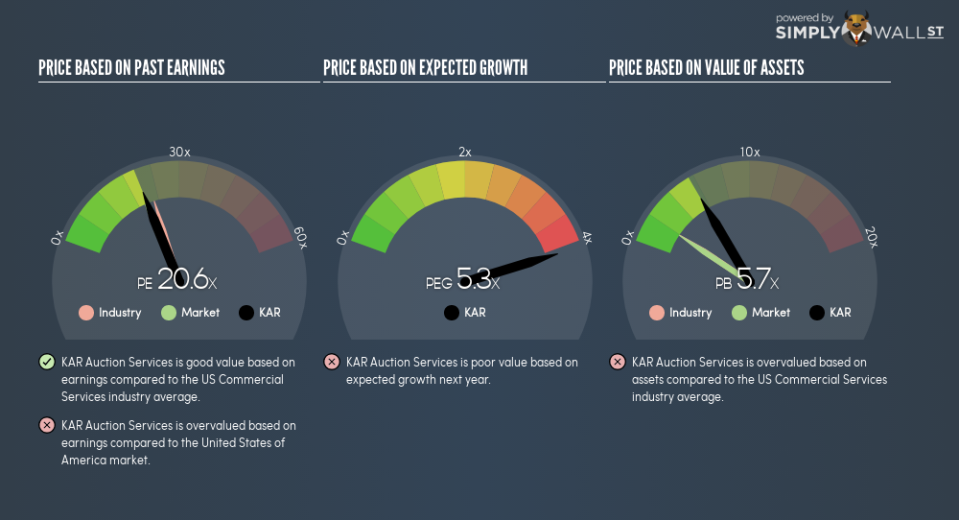Does KAR Auction Services Inc’s (NYSE:KAR) PE Ratio Signal A Buying Opportunity?

The content of this article will benefit those of you who are starting to educate yourself about investing in the stock market and want to learn about the link between company’s fundamentals and stock market performance.
KAR Auction Services Inc (NYSE:KAR) trades with a trailing P/E of 20.6x, which is lower than the industry average of 22.6x. Although some investors may jump to the conclusion that this is a great buying opportunity, understanding the assumptions behind the P/E ratio might change your mind. Today, I will break down what the P/E ratio is, how to interpret it and what to watch out for.
See our latest analysis for KAR Auction Services
Demystifying the P/E ratio
A common ratio used for relative valuation is the P/E ratio. By comparing a stock’s price per share to its earnings per share, we are able to see how much investors are paying for each dollar of the company’s earnings.
P/E Calculation for KAR
Price-Earnings Ratio = Price per share ÷ Earnings per share
KAR Price-Earnings Ratio = $63.74 ÷ $3.1 = 20.6x
The P/E ratio itself doesn’t tell you a lot; however, it becomes very insightful when you compare it with other similar companies. We want to compare the stock’s P/E ratio to the average of companies that have similar characteristics as KAR, such as size and country of operation. A quick method of creating a peer group is to use companies in the same industry, which is what I will do. KAR’s P/E of 20.6 is lower than its industry peers (22.6), which implies that each dollar of KAR’s earnings is being undervalued by investors. This multiple is a median of profitable companies of 25 Commercial Services companies in US including Nutrition Management Services, Eco Energy Tech Asia and QPS Die Cutters and Finishers. You can think of it like this: the market is suggesting that KAR is a weaker business than the average comparable company.
Assumptions to be aware of
Before you jump to conclusions it is important to realise that our assumptions rests on two assertions. Firstly, our peer group contains companies that are similar to KAR. If this isn’t the case, the difference in P/E could be due to other factors. For example, if you compared lower risk firms with KAR, then investors would naturally value it at a lower price since it is a riskier investment. The second assumption that must hold true is that the stocks we are comparing KAR to are fairly valued by the market. If this does not hold true, KAR’s lower P/E ratio may be because firms in our peer group are overvalued by the market.
What this means for you:
Since you may have already conducted your due diligence on KAR, the undervaluation of the stock may mean it is a good time to top up on your current holdings. But at the end of the day, keep in mind that relative valuation relies heavily on critical assumptions I’ve outlined above. Remember that basing your investment decision off one metric alone is certainly not sufficient. There are many things I have not taken into account in this article and the PE ratio is very one-dimensional. If you have not done so already, I urge you to complete your research by taking a look at the following:
Future Outlook: What are well-informed industry analysts predicting for KAR’s future growth? Take a look at our free research report of analyst consensus for KAR’s outlook.
Past Track Record: Has KAR been consistently performing well irrespective of the ups and downs in the market? Go into more detail in the past performance analysis and take a look at the free visual representations of KAR’s historicals for more clarity.
Other High-Performing Stocks: Are there other stocks that provide better prospects with proven track records? Explore our free list of these great stocks here.
To help readers see past the short term volatility of the financial market, we aim to bring you a long-term focused research analysis purely driven by fundamental data. Note that our analysis does not factor in the latest price-sensitive company announcements.
The author is an independent contributor and at the time of publication had no position in the stocks mentioned. For errors that warrant correction please contact the editor at editorial-team@simplywallst.com.

